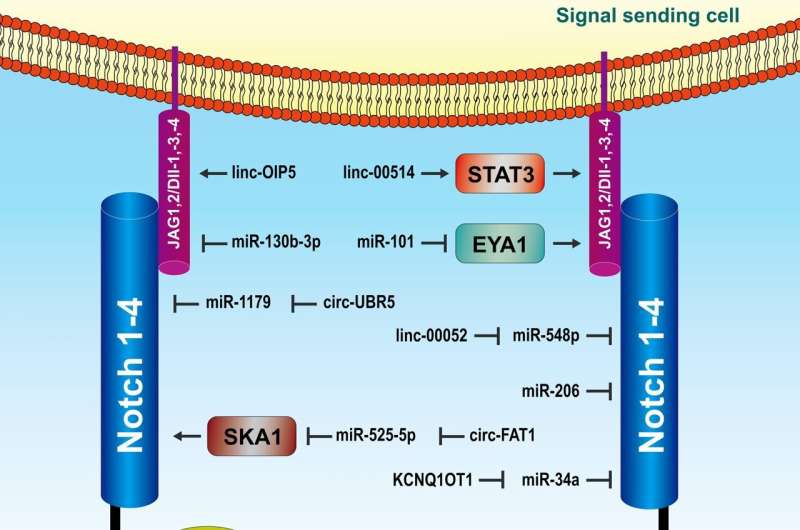This article has been reviewed according to Science X's editorial process and policies. Editors have highlighted the following attributes while ensuring the content's credibility:
fact-checked
proofread
Non-coding RNAs affect breast cancer development through the notch signaling pathway

Breast cancer (BC) remains one of the most challenging cancers to treat, primarily due to its heterogeneity and propensity for metastasis. The Notch signaling pathway is integral to various cellular processes and has been implicated in the development and progression of BC. Non-coding RNAs (NcRNAs), including microRNAs (miRNAs), long non-coding RNAs (lncRNAs), and circular RNAs (circRNAs), have emerged as pivotal regulators of gene expression, affecting cancer biology through their interactions with the Notch pathway.
A comprehensive review underscores the importance of ncRNAs in BC and their potential as therapeutic targets, paving the way for innovative treatments that could significantly impact patient care and prognosis.
The findings are published in the journal Gene Expression.
NcRNAs are transcripts that do not code for proteins but have essential regulatory functions. These include miRNAs, lncRNAs, and circRNAs, each playing unique roles in modulating gene expression and cellular functions. In BC, ncRNAs can function as tumor suppressors or oncogenes, influencing cancer cell proliferation, invasion, and metastasis.
The Notch signaling pathway involves interactions between Notch receptors (Notch1-4) and their ligands, leading to the release of the Notch intracellular domain (NICD) that translocates to the nucleus to regulate gene transcription. Aberrations in this pathway are linked to various BC subtypes. For instance, Notch1, Notch3, and Notch4 are often upregulated in aggressive subtypes like triple-negative breast cancer (TNBC), contributing to poor prognosis.
NcRNAs influence the Notch signaling pathway through several mechanisms. MiRNAs can directly target mRNAs encoding Notch receptors or ligands, thereby modulating pathway activity. LncRNAs can act as molecular sponges, sequestering miRNAs and preventing them from repressing target mRNAs, which leads to changes in Notch signaling. CircRNAs also function similarly by binding to miRNAs, thus impacting the pathway indirectly.
MicroRNAs are small, approximately 22-nucleotide-long RNAs that regulate gene expression post-transcriptionally. Specific miRNAs, such as miR-34a and miR-200 family, are known to target components of the Notch pathway, thus influencing BC progression. These miRNAs can suppress the expression of Notch receptors or ligands, thereby inhibiting pathway activation and reducing tumor growth and metastasis.
Long Non-coding RNAs are longer transcripts that can regulate gene expression at various levels, including chromatin modification, transcription, and post-transcriptional processing. In BC, lncRNAs such as MALAT1 and HOTAIR have been shown to modulate the Notch signaling pathway, either by acting as scaffolds for the assembly of protein complexes that regulate Notch target gene transcription or by sponging miRNAs that target Notch pathway components.
Circular RNAs are a class of ncRNAs formed by back-splicing events, creating covalently closed loop structures. These molecules can act as miRNA sponges, modulating the availability of miRNAs to target mRNAs. For example, circRNA CDR1as has been shown to sequester miR-7, which in turn regulates Notch signaling and impacts BC cell proliferation and invasion.
Understanding the interactions between ncRNAs and the Notch signaling pathway offers promising avenues for BC diagnosis and therapy. NcRNAs can serve as biomarkers for BC subtypes, prognosis, and treatment responses.
Therapeutically, targeting ncRNAs or their interactions with the Notch pathway components could enhance the efficacy of existing treatments and lead to the development of novel therapeutic strategies. For instance, ncRNA-based therapies could be designed to restore the normal function of tumor suppressor miRNAs or inhibit oncogenic lncRNAs and circRNAs, thereby modulating the Notch pathway to inhibit tumor growth and metastasis.
NcRNAs play a crucial role in the regulation of the Notch signaling pathway in BC. By understanding these regulatory mechanisms, researchers can develop better diagnostic tools and therapeutic strategies to manage BC more effectively. Continued research into the ncRNA-Notch pathway interactions will likely yield significant advancements in BC treatment and patient outcomes.
More information: Alireza Ahmadi et al, Non-coding RNAs Affect Breast Cancer Development Through the Notch Signaling Pathway: An Overview, Gene Expression (2024). DOI: 10.14218/GE.2023.00084




















